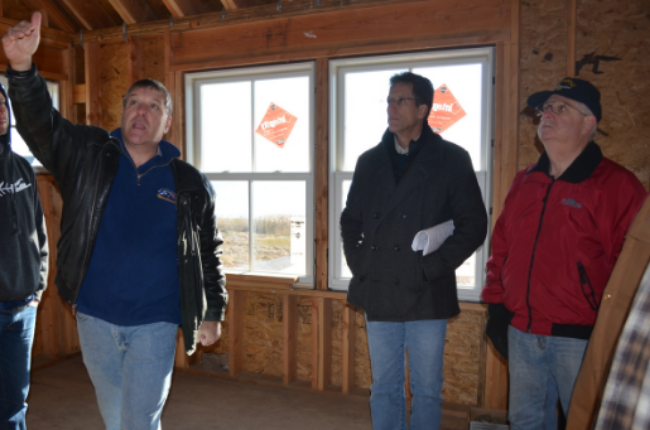According to the LEED for Homes Reference Guide,
“Outdoor air has historically been provided through leaks in the house envelope, but energy concerns have led to construction practices with reduced natural infiltration. Homes with insufficient outdoor air have problems with humidity, odors, and pollutants that can lead to discomfort and increased health risks.”
As a prerequisite in the LEED for Homes green building program, a project must “design and install a whole building ventilation system that complies with ASHRAE Standard 62.2-2007,” a standard developed by the American Society of Heating, Refrigerating and Air-Conditioning Engineers that details ventilation rates and strategies for healthy homes.
LEED for Homes awards two points to projects that go beyond basic ventilation measures and “install a system that provides heat transfer between the incoming outdoor air stream and the exhaust air stream.” An additional point can be earned by projects that undertake commissioning to verify that the ASHRAE 62.2 ventilation requirements are being met by the system. Sunset Green Home plans to capture all three of the available points.
To earn the points and provide healthy air while increasing the home’s energy efficiency, Sunset Green Home will install the ComfoAir 550 ventilation system by Zehnder America. In simple terms, the ComfoAir 550 ERV “pre-conditions” the fresh air as it enters the home by moving it past the exhausting air in a “heat exchanger” to capturing the warmth in the exhaust air in the winter and coolness of the exhaust air in the summer.
Why did we choose Zehnder? As mentioned above, we have two goals for Sunset Green Home’s ventilation:
1. Provide healthy air to occupants, by exhausting stale air from bathrooms and kitchens while supplying fresh air to bedrooms and living spaces
2. Improve the home’s ventilation energy efficiency
Providing fresh air to bedrooms and living spaces is only comfortable for occupants if the temperature differential between the ambient air and the incoming air is very low. After all, in the winter, who wants fresh air in a bedroom if the temperature difference is so great that the air feels drafty? The reverse is true for warm fresh air in an air conditioned room in the summer. We look at a metric called Apparent Sensible Effectiveness (ASE), which compares the temperatures of the two air streams – fresh and stale – as they travel through the ERV, and predicts the difference an occupant will sense. Zehnder’s ComfoAir ERVs are the most effective in the industry at minimizing the temperature differential between fresh and ambient air.
But that’s only part of the story. Sunset Green Home hopes to achieve LEED Platinum certification at completion, and has very aggressive energy efficiency goals. So we also look at Sensible Recovery Efficiency (SRE), which factors in the energy used by the ERV to do its job. And again, Zehnder's products lead the industry in SRE.
We considered other factors as well, that are not specific to Zehnder, but that represent best practice for ERV selection. Best practice ERV design calls for separate dedicated ductwork for supply and return air, which facilitates balancing of the system. In an existing home, installation of an ERV may necessitate using existing ductwork, which tends to be much larger than is needed for balanced ventilation. But Sunset Green Home is new construction, so we are able to install dedicated ducts for the ERV. Another best practice – for healthy air, comfort, and energy efficiency – is to provide continuous ventilation rather than intermittent ventilation. By operating through its own dedicated ducts (rather than relying on a central air system to move fresh air through the ductwork), the Zehnder system is sized to always be “on” – and delivering fresh air to the home.
Sunset Green Home co-hosted a two-day workshop in November with Zehnder America that was attended by trade professionals from as far as New York City and Connecticut (the workshop took place at the office of Coastal Management, Sunset Green Home’s builder, and at the Sunset Green Home site in eastern Long Island).
On Day One, Barry Stephens of Zehnder America lectured the group on the benefits of balanced mechanical ventilation, the various technologies employed by ERV manufacturers, and the characteristics of the Zehnder ComfoAir products.
On Day Two of the workshop, which took place on site at Sunset Green Home, Barry demonstrated how each of the elements of the system functions, and how it should be installed.
Zehnder reviews its customers’ architectural plans as a free service and then engineers customized systems that include the heat exchanger, controls, ductwork, registers and all other required components.
During the installation demonstration portion of the workshop, Barry worked directly from the plans with Sunset Green Home’s HVAC installers from Flanders Heating & Air Conditioning, to assess field conditions and determine any changes that would have to be made based on the location of structural framing members and other factors.
“We’ve been designing and installing these types of systems for over a decade now,” says Doug Matz, owner of Flanders Heating & Air Conditioning. “They really are remarkable in terms of both reducing environmental impact and increasing cost-savings for the homeowner.” He adds, “To be honest, engineering ventilation for LEED-certified projects can be a challenging process. But in this case in particular, given what the owners went through as a result of Hurricane Sandy it’s especially rewarding."
Whether you’re building a new home or undertaking a major renovation, get to know the LEED green building program. You don’t have to seek LEED certification to apply the program’s guidelines to your project. And in the case of balanced mechanical ventilation, you’ll breathe easier knowing that your home is getting all the fresh air it needs.







